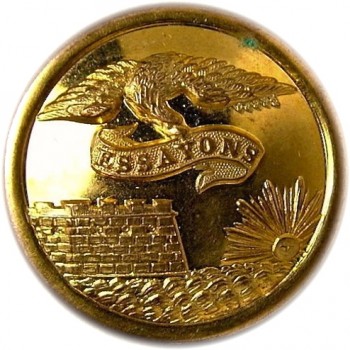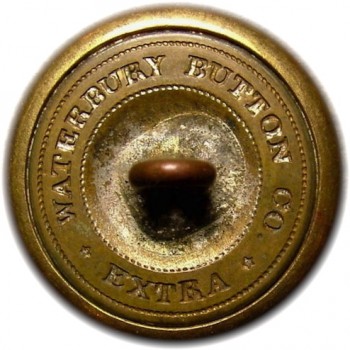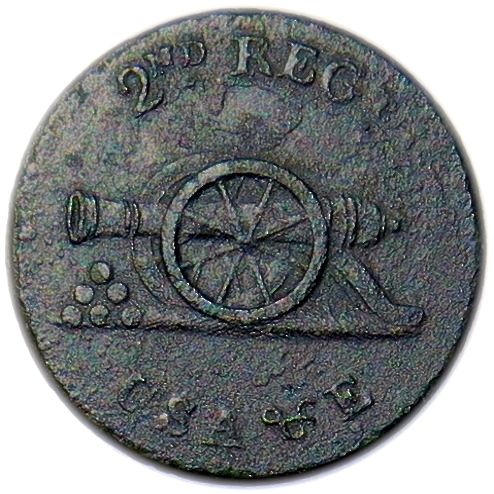
1799-1802 Artillerists & Engineers 2nd Regiment
In the beginning, before America was established as a country, the field artillery branch of the armed services was known as, “The Regiment of Artillery.” It was founded under Colonel Henry Knox. He was unanimously elected by the Continental Congress on November 17th 1775, and on January 1, 1776, a Regiment of Artillery formally entered service. Their official mission statement was to destroy, neutralize, or suppress the enemy with the use of cannons. After the Revolutionary War, the Continental Army along with it’s Artillery units were disbanded for the most part due to various reasons. In 1789, after George Washington took office as the 1st President of the United States, there was only one battalion which consisted of four companies of Artillerists. However, after his second inauguration in 1794, the Corps of Artillerists and Engineers was officially organized. This included the existing four companies of Artillerists, and sixteen new companies divided over four battalions. Then in 1802 under Thomas Jefferson’s administration, there was a reduction of the standing Army, the Engineers were separated from the Artillery, and was transposed into one regiment of 20 companies.
Since the development of the cannon, the word “Artillery” in practice usually meant reference to the use of cannons. During the middle ages, and the early modern period, artillery cannons on the battlefield were positioned and moved with the assistance of horse drawn teams. Prior to loading, the cannon would be well cleaned with a sponge to remove all sparks, filth, and dirt. The powder was added, followed by a wad of paper or hay, and the ball was thrown in. After ramming, the cannon would be aimed with the elevation set using a quadrant and a plummet. At 45 degrees the ball had the utmost range – about ten times the gun’s level range. Any angle above the horizontal line was called random-shot. The officer of artillery had to ensure the cannon was diligently served. Water was available to dip the sponges in and cool the pieces every ten or twelve rounds.
In the late 1770’s, it was said that a 24-pounder could fire 90 to 100 shots a day in Summer, or 60 to 75 in Winter. However, French Artillery Officers managed to have a cannon fire 150 shots daily during siege. A 16 or 12 pounder would fire a little more, because they were more easily served.


1776-82 CONTINENTAL ARTILLERY (American Made)
Color: A Brass Yellow.
Metal: 1-Piece Cast Brass
Size: 21mm. Coat Size
Rarity: R-6
Albert’s: AY 2-A
Present Condition: An Excavated Specimen, Good Planchet Condition, Good High Relief Pattern Remains.
Robert’s Notes: The first appearance of these artillery brass buttons was in 1776, when Henry Knox placed an order for 8 or 10 dozen with Clark the button maker in Concord. Clark also made the Massachusetts State troop numbered buttons. This is an enlisted man’s pattern. The button depicts an Eight Spoke Cannon with a Grand Union Flag hoisted waving above. The high relic pattern is set on a plain field.
Reverse Button Analysis: This is a four hole wooden back type shank that and uses cat gut cord for the attachment.
Library Records Has Limited Information on CA-1:
History: Yes Recorded Sales Price: No
Current Button Owner and Location: ~ Virginia ~
Colonial Williamsburg, VA.
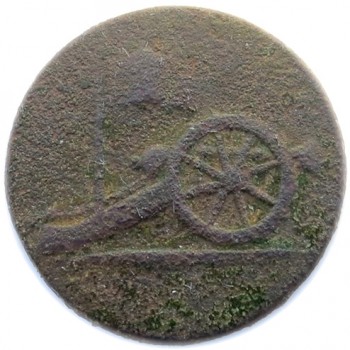

1776-82 CONTINENTAL ARTILLERY
Color: An Ocher Brown with Green Encrustations.
Metal: Slightly Convex, 1-Piece, Raised Design, Cast Brass.
Size: 22.22mm.
Albert’s: AY 2-A
Present Condition: An Excavated Specimen, Fair Planchet Condition, Good High Relief Pattern Remains.
Robert’s Notes: In 1776, Congress authorized the first three Artillery regiments for the Continental Army. Records indicate that Henry Knox placed an order for his regiment early in 1776 with a Mr. Clark who was a button maker. Several buttons of this style were also found in the ruins of Fort Clinton, which was destroyed in the early part of the war of October, 1777. Records show there were three types of Continental Artillery buttons manufactured: solid cast brass, copper repousse with wood backs, and cast pewter. This is an American manufactured button that was issued to the enlisted soldiers early on in the war. This was continually made and issued right up to nearly the of the war. This specimen is the enlisted man’s pattern. The button’s pattern depicts a Cannon with a raised Grand Union Flag in behind it. The button’s design has a Plain Edge Border.
Reverse Button Analysis: This Reverse has a sweated on Copper Loop Shank. The shank is missing.
Library Records Has Limited Information on C A-3:
History: Yes Recorded Sales Price: Yes
Current Button Owner and Location: ~ New York ~
Robert’s Notes: Records show that in 1781, there was an order placed to James Byers, a Philadelphia manufacturer for a smaller waistcoat/vest size of this pattern in cast brass, but the order was denied. Only one size was manufactured. Most likely because of limited funds.
Excavated in the Hudson Highlands.~
The RJ Silverstein Collection.


1776 CONTINENTAL ARTILLERY (Pewter Specimen)
Color: A Grayish Brown.
Metal: Flat, 1-Piece, Raised Design, Cast Pewter.
Size: 24mm.
Albert’s: AY 2-B
Present Condition: An Excavated Specimen, Fair Planchet Condition, Good High Relief Pattern Remains.
Robert’s Notes: This was most likely a crude field mold as a replacement for artillerists. In 1776, Congress authorized the first three Artillery regiments for the Continental Army. Records indicate that Henry Knox placed an order for his regiment early in 1776 with a Mr. Clark who was a button maker. Several buttons of this style were also found in the ruins of Fort Clinton, which was destroyed in the early part of the war of October, 1777. Records show there were three types of Continental Artillery buttons manufactured: solid cast brass, copper repousse with wood backs, and cast pewter. This is an American manufactured button that was issued to the enlisted soldiers early on in the war. This was continually made and issued right up to nearly the of the war. This specimen is the enlisted man’s pattern. The button’s pattern depicts a Cannon with a raised Grand Union Flag in behind it. The button’s design has a Plain Edge Border.
Reverse Button Analysis: This is a One-Piece Loop. The shank is missing.
Library Records Has Limited Information on C A-3B:
History: No Recorded Sales Price: Digger Owner
Current Button Owner and Location:
Picture Courteous of Joseph LeMay
“I agree with you Dale, if the button is dug, you know it carries the imbedded spirit of the person, place, and battle within it’s metal. You get a quick adrenaline rush when you first brush the encrusted dirt from the obverse. You can feel the electricity of excitement flow through the blood in your veins. Your thoughts may briefly wander to the brave soldier who came to fight on this soil. You know in this patriot’s heart he took a brave stand for his ideals, principles, and he fought for what he believed in. So behold your dug military trophy in reverence, its the American Treasure Hunter’s dream.” – Robert


1776-82 CONTINENTAL ARTILLERY (American Made)
Color: A Brass Yellow.
Metal: 1-Piece Cast Brass
Size: 21mm. Coat Size
Rarity: R-6
Albert’s: AY 2-A
Present Condition: An Excavated Specimen, Good Planchet Condition, Good High Relief Pattern Remains.
Robert’s Notes: The first appearance of these artillery brass buttons was in 1776, when Henry Knox placed an order for 8 or 10 dozen with Clark the button maker in Concord. Clark also made the Massachusetts State troop numbered buttons. This is an enlisted man’s pattern. The button depicts an Eight Spoke Cannon with a Grand Union Flag hoisted waving above. The high relic pattern is set on a plain field.
Reverse Button Analysis: This is a four hole wooden back type shank that and uses cat gut cord for the attachment.
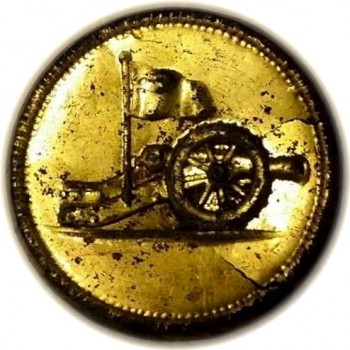

1781 CONTINENTAL ARTILLERY (French Import Style)
Color: A Coppery Gold.
Metal: 2-Piece Repousse Sheet Copper, Gilded.
Size: 22mm.
Rarity: R-3
Albert’s: AY 1
Present Condition: An Excavated Specimen, Strong Planchet Condition, Strong High Relief Pattern Remains.
Robert’s Notes: The first appearance of these French Import style copper repousse buttons probably comes from an order placed by Colonel John Laurens in April 1781. The order was filled by Sabatier Sons and Despres. It arrived on the French ship Duque Dourin in Boston Harbor in August 22, 1781. Originally this gilded button was slated for officers, but the quantities found throughout the Hudson Valley, NY indicate it was used by enlisted men as well. This button was reported to be wrapped around Florida’s Boxwood for the shank. This French import style artillery button is made of Repousse Sheet Copper that was gilded. The reverse shank was a wooden back with cat gut cord to use as the sew attachment. The button’s pattern depicts a Cannon with a raised Grand Union Flag behind. The high relief pattern is set on a flat field with a Raised Pie Crust Border. This button type has been mostly excavated around the various forts in the New York’s Hudson Valley Region, and around West Point.
Reverse Button Analysis: This is a four hole wooden back type shank that and uses cat gut cord for the attachment.
Library Records Has Limited Information on CA-1:
History: Yes Recorded Sales Price: No
Current Button Owner and Location: ~ Virginia ~
Dug with 4-5 others in Wilmington North Carolina a few years ago.
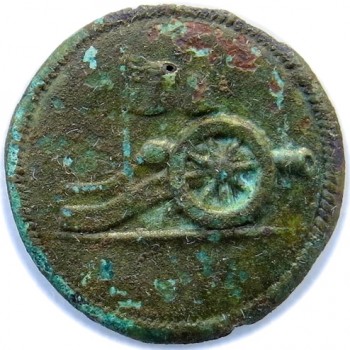

1781 CONTINENTAL ARTILLERY (French Import Style)
Color: An Ochre Pigment with Green Encrustations.
Metal: 2-Piece Repousse Sheet Copper, Gilded.
Size: 23.70mm.
Albert’s: AY 1
Rarity: R-3 (Only 2 reported examples are known to have survived that have a replacement pewter back for the shank).
Present Condition: An Excavated Specimen, Good Planchet Condition, Good High Relief Pattern Remains.
Robert’s Notes: This button appears to have been modified by a soldier after the wood back was broken off or lost. Originally this button was slated for Artillery officers, but Don Troiani believes that enlisted men might have used these also because of the quantities found throughout the Hudson Valley, New York. This button was originally wrapped around Florida’s Boxwood for the shank. This French import style artillery button is made of Repousse Sheet Copper that was Gilded. The reverse shank was a wooden back with cat gut cord to use as a sew attachment. When i bought this button from Mr. Troiani, he told me that he believed that a soldier in the field must have crimped it around a pewter “USA” button, but not 100% certain of the type. The shank style makes me believe it was another type of pewter button, so I didn’t risk damaging the Copper Repousse to find out. The button’s pattern depicts a Cannon with a raised Grand Union Flag behind. The high relief pattern is set on a flat field with a Raised Pie Crust Border. This button type has been mostly excavated around the various forts in the New York’s Hudson Valley Region, and around West Point.
Library Records Has Limited Information on CA-2:
History: Yes Recorded Sales Price: Yes
Current Button Owner and Location: ~ New York ~
Excavated in the Hudson Highlands.
The RJ Silverstein Collection.~
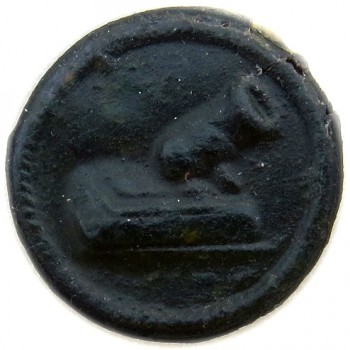
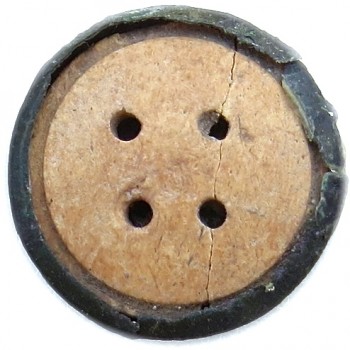
1778 CONTINENTAL ARTILLERY OFFICER’S COEHORN MORTAR BUTTON
Color: Black With Brown Undertones.
Metal: Flat, 2-Piece, Raised Design, Copper Repousse.
Size: 17.87mm.
Albert’s: AY 3
Present Condition: An Excavated Specimen, Strong Planchet Condition, Strong High Relief Pattern Remains.
Robert’s Notes: There are two known die variants for the Coehorn Mortar button. One is made for Officers, and one is made for the enlisted men. The officer’s pattern is made of a Thin Copper Repousse Shell with a Wood or Bone Back. The reverse shank would use a Cat Gut Cord for the attachment. The officer’s patten has also has a distinct Single Rope raised border. The second is the Enlisted Man’s Pattern. This is made of cast pewter with a Double Concentric Ring Border. Albert notes in his book that there was a brass one made for enlisted men, but no specimens have turned up as of date. Both patterns are around 17-18mm. The smaller Coehorn Mortar button was to be used as a cuff button. It was designed to be worn in-conjunction with the larger size artillery cannon patterns. Officer’s patterns are difficult to obtain and quite rare. Enlisted man’s patterns are found for sale from time to time, but the pewter is usually in very poor condition. This Officer’s pattern depicts a Coehorn Mortar on a plain flat field with a raised Single Rope edge border.
Reverse Button Analysis: This is a two-piece button with a wood back. The Wood has a crack, but intact. Cat gut cord missing.
Library Records Has Limited Information on C A-4:
History: Yes Recorded Sales Price: Yes
Current Button Owner and Location: ~ New York ~
This was Dug at Camp Robinson in Garrison, New York.
The RJ Silverstein Collection.

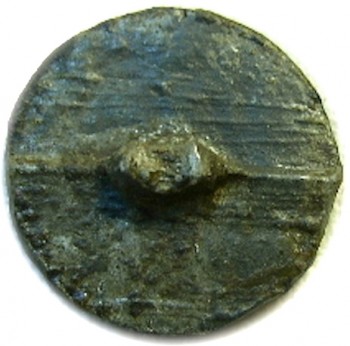
1778 CONTINENTAL ARTILLERY ENLISTED MAN’S COEHORN MORTAR BUTTON
Color: Silver with Charcoal Green Patches.
Metal: Flat, 1-Piece, Raised Design, Cast Pewter.
Size: 17mm.
Albert’s: AY 4-B
Present Condition: An Excavated Specimen, Strong Planchet Condition, Strong High Relief Pattern Remains.
Robert’s Notes: There are two known die variants for the Coehorn Mortar button. One is made for Officers, and one is made for the enlisted men. The officer’s pattern is made of a Thin Copper Repousse Shell with a Wood or Bone Back. The reverse shank would use a Cat Gut Cord for the attachment. The officer’s patten has also has a distinct Single Rope raised border. The second is the Enlisted Man’s Pattern. This is made of cast pewter with a Double Concentric Ring Border. Albert notes in his book that there was a brass one made for enlisted men, but no specimens have turned up as of date. Both patterns are around 17-18mm. The smaller Coehorn Mortar button was to be used as a cuff button. It was designed to be worn in-conjunction with the larger size artillery cannon patterns. Officer’s patterns are difficult to obtain and quite rare. Enlisted man’s patterns are found for sale from time to time, but the pewter is usually in very poor condition. This Enlisted man’s pattern depicts a Coehorn Mortar on a plain flat field with a raised Concentric Ring border.
Reverse Button Analysis: This is a one-piece button faith a loop shank.
Library Records Has Limited Information on C A-5:
History: No Recorded Sales Price: No
Current Button Owner and Location: ~ New Jersey ~
Jim Dews, The Keemakoo’s Collection.

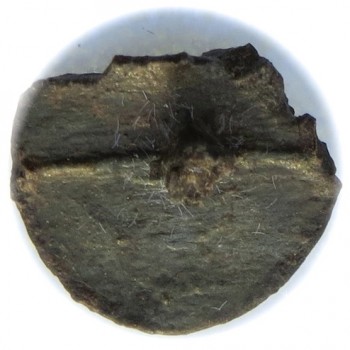
1778 CONTINENTAL ARTILLERY ENLISTED MAN’S COEHORN MORTAR BUTTON
Color: Silver with Charcoal Patches.
Metal: Flat, 1-Piece, Raised Design, Cast Pewter.
Size: 17.66mm.
Albert’s: AY 4-B
Present Condition: An Excavated Specimen, Poor Planchet Condition, Good High Relief Pattern Remains.
Robert’s Notes: There are two known die variants for the Coehorn Mortar button. One is for an Officer’s pattern made of Copper Shell with a Wood Back and Cat Gut Cord was used for the attachment. This patten has a Single Line Raised border. The other is an enlisted man’s pattern made of cast pewter with a Double Concentric Ring Border. Both patterns are around 17mm. The Coehorn Mortar designed to be used as a cuff button to be worn in-conjunction with the larger size cannon artillery patterns. Officer’s patterns are difficult to obtain and quite rare. Enlisted man’s patterns are found for sale from time to time, but the pewter is in poor shape. This enlisted man’s pattern depicts a Cohorn Mortar on a plain flat field with a raised Double Concentric Ring border.
Reverse Button Analysis: This is a one-piece button with a loop shank.
Library Records Has Limited Information on CA-5-A:
History: Yes Recorded Sales Price: Yes
Current Button Owner and Location: ~ New York ~
Excavated in the Hudson Highlands.
The RJ Silverstein Collection.
Notes: There is a common misconception about the use of Mortars by Artillerists. Mortars are not field Artillery weapons as one might think, they are organic to infantry units, and they are used by infantry personnel.
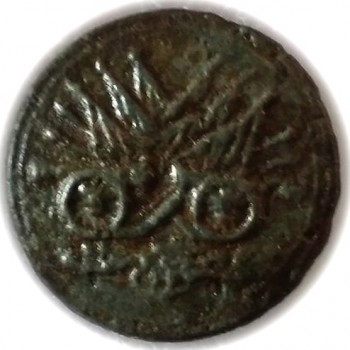
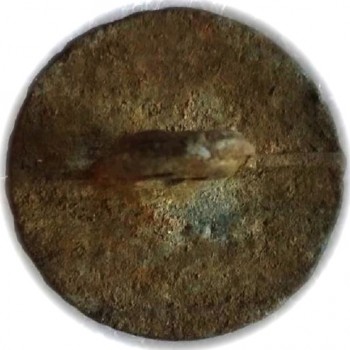
1778-83 CONTINENTAL ARTILLERY (American Made-French Design)
Color: Silver with Orangey-Brown Patches.
Metal: Flat, 1-Piece, Raised Design, Cast Pewter.
Size: 18mm.
Albert’s: AY 5-Bv
Present Condition: An Excavated Specimen, Strong Planchet Condition, Strong High Relief Pattern Remains.
Robert’s Notes: This artillery pattern was used both by officer’s and enlisted men. The officers pattern was made of repousse sheet copper with a wooden back. The coat size is 25mm., and the cuff size is around 17-18mm. The enlisted man’s coat size is undetermined, but the cuff size is confirmed at 18mm. The button depicts Back to Back Cannons with an Array of Trophy Flags. Albert mentions that the flags are striped, but it is uncertain. They could just be creases. There appears to be a Pyramid of Six Cannon Balls in the center with a couple beside the wheels. This die variant has a Double Concentric Ring edge border. The officers appears to only have a single concentric ring.
Reverse Button Analysis: This is a one-piece button with a loop shank.
Library Records Has Limited Information on CA-6:
History: Yes Recorded Sales Price: No
Current Button Owner and Location: ~ Virginia ~
W. Leigh Collection.
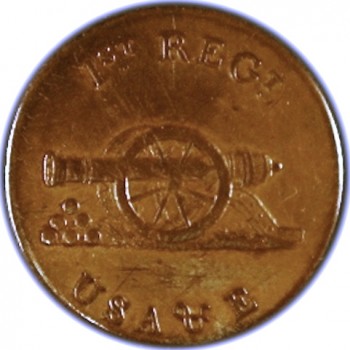

1799-1802 Artillerists & Engineers 1st Regiment
Color: A Golden Pewter.
Metal: Flat, 1-Piece, Raised Design, Gilded Brass.
Size: 22.mm. Coat Size
Albert’s Number: AY 08 RV 75
Tice’s Number: AEO40
Variation: Ringed Cannon with a Large Breech / Six Cannon Balls / 2nd REGt./ US / A & E.
Present Condition: An Excavated Specimen, Strong Planchet Condition, Strong High Relief Relief Pattern Remains.
Robert’s Notes: The Regiment of Artillerist and Engineers was originally organized on April 27, 1798. These new regiments would consist of three battalions, and each would have three companies within. On March 2, 1799, an additional battalion was added, and on Mach 3rd 1799, the regiment was designated as the First Regiment of Artillerists and Engineers. The button’s pattern depicts a Ringed Cannon with a Large Breech sitting on a field pointing right. Under the cannon’s muzzle is a stack of Six Cannon Balls stacked in a Pyramidal Shape. Arced above is the regiment designation, “1st REGt.” and below is the country’s initials, “U S” and the military units designation initials, “A & E” in all capital Roman font letters. The high relief pattern is set on a plain flat field. Specimens rarely surface on the market, and when they do they usually demand a hefty premium.
Reverse Button Analysis: This is a flat one-piece button with a loop shank. The shank is original and intact, but bent inward. *CARTER*/LOMBARD STREET rm within a channel of a rope rm rings.
Library Records Has Limited Information on CA-7:
History: No Recorded Sales Price: Yes
Current Button Owner and Location: ~ Virginia~


1799-1802 Artillerists & Engineers 2nd Regiment
Color: A Golden Pewter.
Metal: Flat, 1-Piece, Raised Design, Gilded Brass.
Size: 22.20mm.
Albert’s Number: AY 09 RV 75
Tice’s Number: AEO41
Variation: Ringed Cannon with a Large Breech / Six Cannon Balls / 2nd REGt./ US / A & E.
Present Condition: An Excavated Specimen, Strong Planchet Condition, Strong High Relief Relief Pattern Remains.
Robert’s Notes: The Regiment of Artillerist and Engineers was originally organized on April 27, 1798. These new regiments would consist of three battalions, and each would have three companies within. On March 2, 1799, an additional battalion was added, and on Mach 3rd 1799, the regiment was designated as the Second Regiment of Artillerists and Engineers. The button’s pattern depicts a Ringed Cannon with a Large Breech sitting on a field pointing right. Under the cannon’s muzzle is a stack of Six Cannon Balls in a pyramidal shape. Arced above is the regiment designation, “2nd REGt.” and below is the country’s initials, “U S” and the military units designation initials, “A & E” in all capital Roman font letters. The high relief pattern is set on a plain flat field. Specimens rarely surface on the market, and when they do they usually demand a hefty premium.
Reverse Button Analysis: This is a flat one-piece button with a loop shank. The shank is original and intact, but bent inward. *CARTER*/LOMBARD STREET rm within a channel of a rope rm rings.
Library Records Has Limited Information on CA-8:
History: Yes Recorded Sales Price: Yes
Current Button Owner and Location: ~ New York ~
Dug in Upstate New Hampshire.~
The RJ. Silverstein Collection.
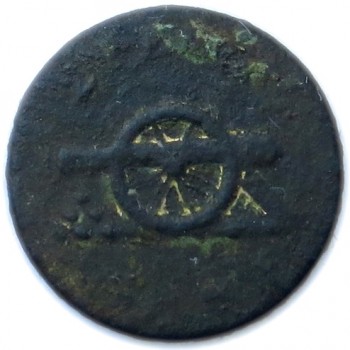
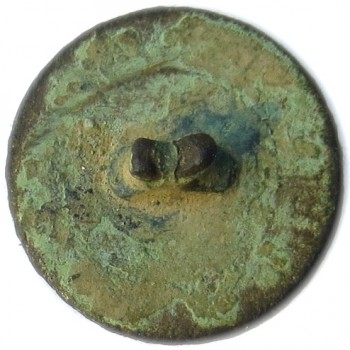
1799-1802 Artillerists & Engineers 2nd Regiment
Color: A Golden Pewter.
Metal: Flat, 1-Piece, Raised Design, Gilded Brass.
Size: 14.39mm. Cuff Button
Albert’s Number: Goes With AY 09, Unlisted RV 300?
Tice’s Number: AEO41
Variation: Ringed Cannon with a Large Breech / Six Cannon Balls / 2nd REGt./ US / A & E.
Present Condition: An Excavated Specimen, Good Planchet Condition, Good High Relief Relief Pattern Remains.
Robert’s Notes: William Leigh from VA claims to have seen another cuff specimen of the 2nd. Regt. No other cuffs have been reported. I guess exceedingly rare in the cuff size. The Regiment of Artillerist and Engineers was originally organized on April 27, 1798. These new regiments would consist of three battalions, and each would have three companies within. On March 2, 1799, an additional battalion was added, and on Mach 3rd 1799, the regiment was designated as the Second Regiment of Artillerists and Engineers. The button’s pattern depicts a Ringed Cannon with a Large Breech sitting on a field pointing right. Under the cannon’s muzzle is a stack of Six Cannon Balls in a pyramidal shape. Arced above is the regiment designation, “2nd REGt.” and below is the country’s initials, “U S” and the military units designation initials, “A & E” in all capital Roman font letters. The high relief pattern is set on a plain flat field. Specimens in any size rarely surface on the market, and when they do they usually demand a hefty premium.
Reverse Button Analysis: This is a flat one-piece button with a loop shank. The shank is original and intact, but bent inward. *CARTER*/LOMBARD STREET rm within a channel of a rope rm rings.
Library Records Has Limited Information on CA-8:
History: Yes Recorded Sales Price: Yes
Current Button Owner and Location: ~ New York ~
Dug in Camden Delaware by William Cafone in Aug. 2014.~
The RJ. Silverstein Collection.
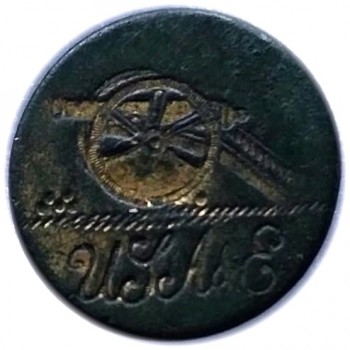
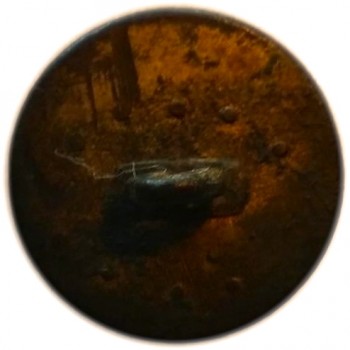
1800’s Artillerists & Engineers ?
Color: Emerald Green with Gold Highlights.
Metal: Flat, 1-Piece, Impressed Design, Gilt Copper.
Size: 22.mm.
Albert’s Number: AY 10 (Unauthenticated)
Tice’s Number: Unlisted.
Variation: Reeded Cannon Wheels / Six Cannon Balls / Impressed Pattern / USA & E Calligraphy.
Present Condition: An Excavated Specimen, Strong Planchet Condition, Strong High Relief Relief Pattern Remains.
Robert’s Notes: Tice doesn’t list this variation, and Albert has it as “Unauthenticated.” This could be because there is a later date (1800’s) style “Omega Shank.” By this time, most military button motifs were done in high relief. What captures my imagination is the Reeded Carriage Wheels. This was a Guild instructed old-technique that was not usually displayed on military buttons. Reeded edges were used on coins to thwart people stealing the weight off the silver or gold (“Shaving would be Detected.”) The motif does reflect Artist Guild work, and we do know they did make some of the earlier military buttons, so this one was most likely geared for A & E Officers. The button’s pattern depicts a Cannon with a Small Breech sitting on a field pointing right. Under the cannon’s muzzle is a stack of Five Cannon Balls in a pyramidal shape. There is also One Cannon Ball behind the Carriage Wheel. Bellow is the country’s initials, “U S A & E” Impressed in Calligraphy Style letters. The high relief pattern is set on a plain flat field. This is the only specimen I have ever come upon.
Reverse Button Analysis: This is a flat one-piece button with an Omega Shank. The shank is original, straight.
Library Records Has Limited Information on CA-9:
History: Yes Recorded Sales Price: No
Current Button Owner and Location: ~ Virginia ~
Robert’s Notes: On April 1, 1802, the first and second regiment of Artillerists and Engineers changed it’s official designation to just the Regiment of Artillerists. With this new re-designation came a new style of button. From 1802-1808, the 1st Regiment of Artillery would use a device depicting an eagle standing on a cannon with a variety of military objects in the background. The 1st Regt. unit designation would be inscribed below.
Robert’s Notes: Antebellum is a 19th Century Latin word that is defined as either occurring, or existing before a particular war: Ante- before, vellum-war. A lot of collectors like to use the terminology when referencing their Pre-Civil War buttons.
~ Corps of Engineers ~
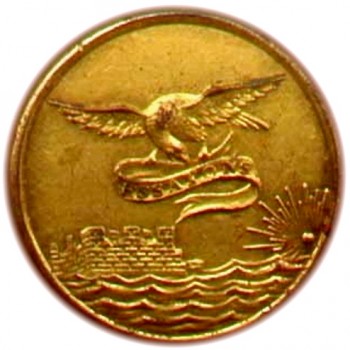
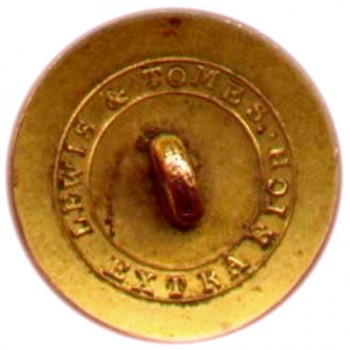
1815-30’s Army Corps of Engineers
Color: Tinted Down Brass Yellow.
Metal: Slightly Convex, 1-Piece, Raised Design, Gilt Brass.
Size: 24mm. Coat Size
Albert’s Number: EG 3: RV 25
Tice’s Number: EG 100B
Variation: Eagles Wing Tips Face Downward / Short Sun Rays / Narrow Banner Ribbon / Small Sun.
Present Condition: A Non Excavated Specimen, Strong Planchet Condition, Strong High Relief Pattern Remains.
Robert’s Notes: This British die variant isn’t listed in Tice’s book, but the Lewis & Tomes backmark dates between 1815-1830. This officer’s button depicts an Eagle in flight with Downward Facing Wing Tips. In the Eagle’s Beak is a Narrow Banner Ribbon with the Engineer’s 1806 motto, “ESSAYONS.” The Sun’s Rays are short, and only One Ray Reaches the Ribbon. The sun is a small raised stipple. This variant shows a Bastion with an adjacent wall. There is an outside raised Concentric Ring Edge Border.
Reverse Button Analysis: This is a slightly concave two-piece button with a soldered on loop shank. The shank is original, straight, and intact. LEWIS & TOMES, / EXTRA RICH. rm channel marker.
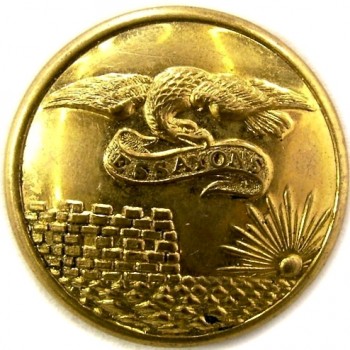
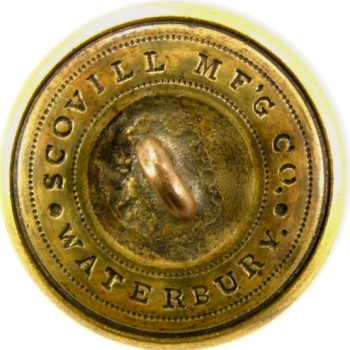
1860-65 Army Corps of Engineers
Color: Scuff Flat Brass Yellow.
Metal: Low-Convex 2-Piece, Raised Design, Gold Plate.
Size: 23mm. Coat Size
Albert’s Number: EG 6: RV 05
Tice’s Number: EG 215A.2
Variation: Eagle With Upward Facing Wing Tips/ Suns Rays Long / Sun is Larger / Wide Banner Ribbon.
Present Condition: A Non Excavated Specimen, Strong Planchet Condition, Strong High Relief Pattern Remains.
Robert’s Notes: The button depicts an Eagle in flight with Upward Pointing Wing Tips. The Eagle’s body in this die variant tends to be wider. In the Eagle’s Beak is a Wide Banner Ribbon with the Engineer’s 1806 motto, “ESSAYONS” in raised Roman font capital letters. The Sun’s Rays are Long and Reach the Ribbon. The Sun is a Large Round Stipple. In this depiction, there is a Single Bastion Wall. There is an outside raised Concentric Ring Edge Border.
Reverse Button Analysis: This is a two-piece button with a soldered on loop shank. The shank is original, straight, and intact. . SCOVILL MF’G CO. / . WATERBURY..RMDC

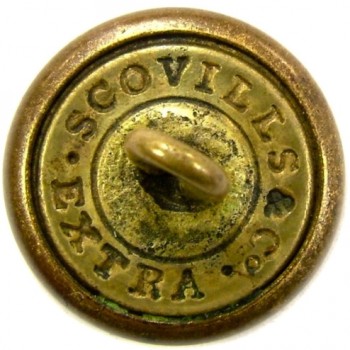
1815-30’s Army Corps of Engineers
Color: Coppery Brass Yellow.
Metal: Low-Convex, 2-Piece, Raised Design, Gilt Brass.
Size: 15mm. Cuff Size
Albert’s Number: EG 6: RV 25
Tice’s Number: EG 215 Bs.1 Using As.1 Backmark
Variation: Eagles Wing Tips Face Downward / Space Between Sun and Rays / Castle Two Dimensions.
Present Condition: An Excavated Specimen, Strong Planchet Condition, Strong High Relief Pattern Remains.
Robert’s Notes: In this variant, there is a flat spot between sun and rays. The Sun’s Rays reach into the Ribbon. The sun depiction is a Small Raised Stipple. The Eagle is in flight, and it’s Wing Tips are facing Downward. In the Eagle’s Beak is a Wide Banner Ribbon with the Engineer’s 1806 motto, “ESSAYONS” in large Roman font capital letters. This die variant shows a Bastion with an adjacent wall. There is a raised Concentric Ring Edge Border.
Reverse Button Analysis: This is a two-piece button with a soldered on loop shank. The shank is original, straight, and intact.
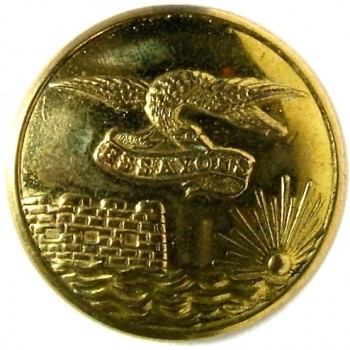
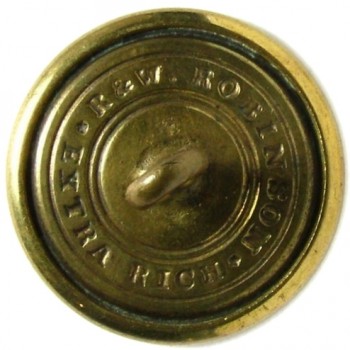
1840’s Army Corps of Engineers
Color: Antique Greenish-Yellow Brass.
Metal: Low-C0nvex, 2-Piece, Raised Design, Gilt Brass.
Size: 22.53mm. Coat Size
Albert’s Number: EG 6: RV 25
Tice’s Number: EG 215 E.1
Variation: Eagles Wing Tips Face Upward / Sun Rays Almost Reach Ribbon / Bastion Single Wall.
Present Condition: A Non Excavated Specimen, Strong Planchet Condition, Strong High Relief Pattern Remains.
Robert’s Notes: This officer’s button depicts an Eagle in flight, and it’s Wing Tips are facing Upward. In the Eagle’s Beak is a Wide Banner Ribbon with the Engineer’s 1806 motto, “ESSAYONS” in raised Roman font capital letters. The inscription is set on a Stippled base. The Sun’s Rays almost reach the Ribbon. The sun is a Large Raised Stipple. This variant shows a Single Bastion Wall.There is an outside raised Concentric Ring Edge Border.
Reverse Button Analysis: This is a two-piece button with a soldered on loop shank. The shank is original, straight, and intact.
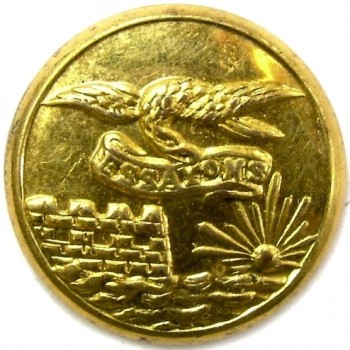
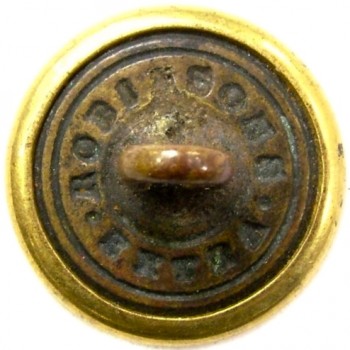
1815-30’s Army Corps of Engineers
Color: Bright Brass Yellow.
Metal: Low-C0nvex, 2-Piece, Raised Design, Gilt Brass.
Size: 13.7mm. Cuff or Hat Size
Albert’s Number: EG 6: RV 25
Tice’s Number: EG 215 Es.1
Variation: Eagles Wing Tips Face Upward / Sun Rays Just Touch Banner Ribbon / Bastion Single Wall.
Present Condition: A Non Excavated Specimen, Strong Planchet Condition, Strong High Relief Pattern Remains.
Robert’s Notes: Robinson made these buttons for Engineer officer’s sleeves or hats. The button depicts an Eagle in Flight and the Wing Tips are facing Upward. In the Eagle’s Beak is a Wide Banner Ribbon with the Engineer’s 1806 motto, “ESSAYONS” in raised Roman font capital letters. The Sun’s Rays just touch the Banner Ribbon. The Sun is a Large Round Raised Stipple. This variant shows a Single Bastion Wall. There is an outside raised Concentric Ring Edge Border.
Reverse Button Analysis: This is a two-piece button with a soldered on loop shank. The shank is original, straight, and intact. . ROBINSONS . EXTRA (Robinson RW23as)
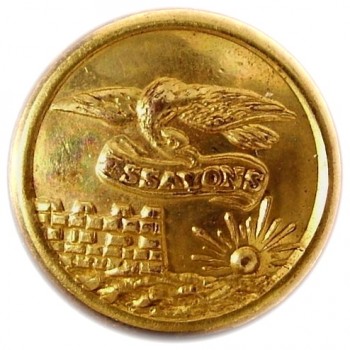

1815-30’s Army Corps of Engineers
Color: Oxidized Gold.
Metal: Low-C0nvex, 2-Piece, Raised Design, Gilt Brass.
Size: 15mm. Cuff Size
Albert’s Number: EG 6: RV 25
Tice’s Number: EG 215 Es.1 Unlisted Backmark
Variation: Eagles Wing Tips Face Upward / Sun Rays Almost Touch Ribbon / Bastion Single Wall.
Present Condition: A Non Excavated Specimen, Strong Planchet Condition, Strong High Relief Pattern Remains.
Robert’s Notes: Unlike the coat examples, this smaller cuff’s variant’s Sun Rays Do Reach the Ribbon. In this depiction, the Eagle’s is in flight and the Wing Tips are facing Upward. In the Eagle’s Beak is a Wide Banner Ribbon with the Engineer’s 1806 motto, “ESSAYONS” in raised Roman font capital letters. The Sun’s Rays almost touch the Banner Ribbon. The sun is a Large Raised Stipple. This variant shows a Single Bastion Wall. There is a raised Concentric Ring Edge Border.
Reverse Button Analysis: This is a two-piece button with a soldered on loop shank. The shank is original, straight, and intact.
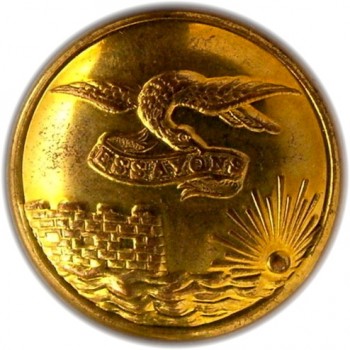

1860’s Army Corps of Engineers
Color: Tarnished Gold.
Metal: Low-C0nvex, 2-Piece, Raised Design, Gilt Brass.
Size: 22.71mm. Coat Size
Albert’s Number: EG 6G: RV 25
Tice’s Number: EG 215 F: Unlisted
Variation: Eagles Wing Tips Face Upward / Sun Rays Almost Reach Ribbon / Bastion Single Wall.
Present Condition: A Non Excavated Specimen, Strong Planchet Condition, Strong High Relief Pattern Remains.
Robert’s Notes: This button was probably manufactured by D. Evans for Schuyler & Hartley in the 1860’s. This officer’s button depicts an Eagle in flight, and it’s Wing Tips are facing Upward. In the Eagle’s Beak is a wide in-scripted banner ribbon with the Engineer’s 1806 motto, “ESSAYONS” in raised Roman font capital letters. This inscription is set on a stippled base. The Sun’s Rays almost reach the Banner Ribbon. The sun is a Large Raised Stipple. This variant shows a Single Bastion Wall. There is a raised Concentric Ring Edge Border.
Reverse Button Analysis: This is a two-piece button with a soldered on copper loop shank. The shank is original, straight, and intact. SCHUYLER HARTLEY & GRAHHAM * / * NY * inner ring of short hyphens.
1860’s Army Corps of Engineers
Color: Reflective Gold.
Metal: Low-C0nvex, 2-Piece, Raised Design, Gilt Brass.
Size: 23.1mm. Coat Size
Albert’s Number: EG 6G: RV 25
Tice’s Number: EG 215 G.1
Variation: Eagles Wing Tips Face Upward / Sun Rays Are Short of the Banner Ribbon / Large Flat Stipple.
Present Condition: A Non Excavated Specimen, Strong Planchet Condition, Strong High Relief Pattern Remains.
Robert’s Notes: This button was made by Waterbury button co for officers in the Corps of Engineers. This officer’s button depicts an Eagle in Flight, and it’s Wing Tips are facing Upward. In the Eagle’s Beak is a Wide Banner with the Engineer’s 1806 motto, “ESSAYONS” in large capital letters. This inscription is set on a Stippled Base. The Sun’s Rays are Short of the Banner Ribbon. The Sun is a Large Raised Flat Stipple. This variant shows a Single Bastion Wall. There is a raised Concentric Ring Edge Border.
Reverse Button Analysis: This is a two-piece button with a soldered on copper loop shank. The shank is original, straight, and intact. WATERBURY BUOON CO. /* EXTRA * (WATERBURY 17)
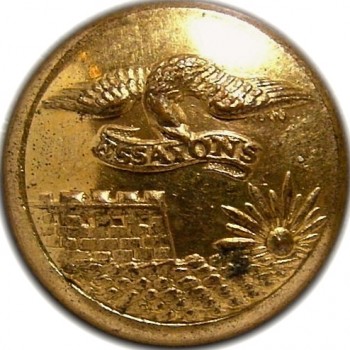
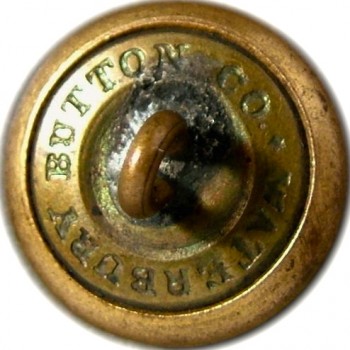
1860’s Army Corps of Engineers
Color: Brown Speckled Gold.
Metal: Low-C0nvex, 2-Piece, Raised Design, Gilt Brass.
Size: 16mm. Cuff Size
Albert’s Number: EG 6G: RV 25
Tice’s Number: EG 215 G Unlisted Variant
Variation: Eagles in Flight / Sun’s Rays Almost Touch the Banner Ribbon / Large Round Stipple.
Present Condition: An Excavated Specimen, Strong Planchet Condition, Strong High Relief Pattern Remains.
Robert’s Notes: This small cuff button was made by Waterbury button company for officers in the Corps of Engineers. This officer’s button depicts an Eagle in Flight, and it’s Wing Tips are facing Upward. In the Eagle’s Beak is a Narrow Banner with the Engineer’s 1806 motto, “ESSAYONS,” in large capital letters. This inscription is set on a Stippled Base. The Sun’s Rays are almost touch the Banner Ribbon. The Sun is a Large Round Raised Stipple. This variant shows a Single Bastion Wall. There is a raised Concentric Ring Edge Border.
Reverse Button Analysis: This is a two-piece button with a soldered on copper loop shank. The shank is original, straight, and intact. WATERBURY BUTTON CO* (WATERBURY 22SMALL)
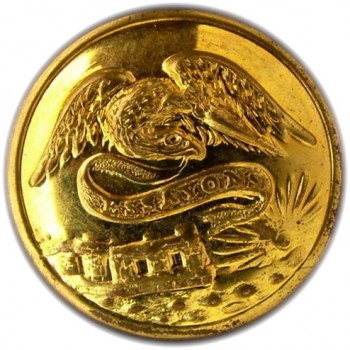
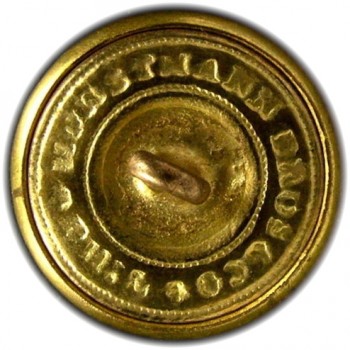
1860’s Army Corps of Engineers
Color: Antique Gold.
Metal: Low-Convex, 2-Piece, Raised Design, Gilt Brass.
Size: 22.5mm. Coat Size
Albert’s Number: EG 6: Not Listed
Tice’s Number: EG 215UK.1
Variation: Eagles Wing Tips Face Downward / Space Between Sun and Rays / Bastion Two Dimensions.
Present Condition: A Non Excavated Specimen, Strong Planchet Condition, Strong High Relief Pattern Remains.
Robert’s Notes: This button was probably manufactured in the 1860’s by Steele & Johnson for Horstman. In this die variant, there is a flat spot between sun and rays. The Sun’s Rays reach into the Banner Ribbon. The Sun is a Small Raised Stipple. The Eagle’s Wing are Close to the Body and the Tips are facing Downward. In the Eagle’s Beak is an in-scripted banner with the Engineer’s 1806 motto, “ESSAYONS” in Roman font capital letters. This variant shows a Bastion with an adjacent wall. There is a raised Concentric Ring Edge Border.
Reverse Button Analysis: This is a two-piece button with a soldered on loop shank. The shank is original, straight, and intact.
~ Topographical Engineers ~
In 1813 as part of the General Staff, the U.S. Army organized the first group of Topographical Engineers. This group of individuals usually worked independently, and did not follow normal Army protocols or regulations. They were map makers who went out on a horse in unknown territory with a compass and surveyed the land. In 1831, they became their own separate Corps of Engineers. There primary duty officially was to make maps, aid the troops in selecting the best ground to fight the enemy, and plot routes for troop movement and concealment from the enemy. By 1863, the Topographical Engineers was absorbed into the Corps of Engineers.
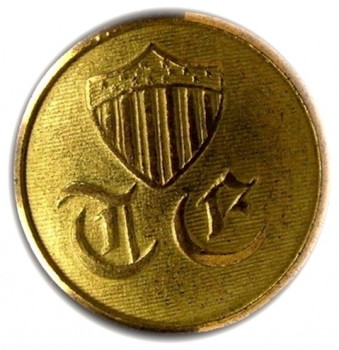
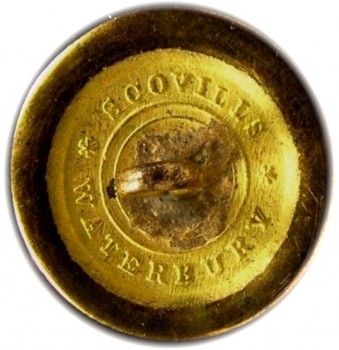
1832 Topographical Engineers
Color: Gold!
Metal: 1-Piece, Low Convex Gilded Brass.
Size: 23mm.
Albert’s Number: TE 3: RV 25
Tice’s Number: TE206B.2
Variation: 1-Piece/ 2 Stars on Top Row.
Present Condition: A Non Excavated Specimen, Exceptional Planchet Condition, An Exceptional High Relief Pattern Remains.
Isabela’s Notes: This button was made to the Army’s specifications of 1832. The button depicts A large American Shield with 13 five-pointed stars on the top lined field. (Some Variants have one star on top row). There are thirteen alternating thickness vertical stripes on the lower half of the shield. Below the shield is the initials in Old English, “TE” for Topographical Engineers. The whole pattern is set upon an evenly lined field with a thin raised edge border.
Reverse Button Analysis: This is a one-piece button with a loop shank. The shank is possibly re-soldered or original, straight, and intact. *SCOVILLS * WATERBURY 2 inner rm rings.
The H. Ridgeway Collection.
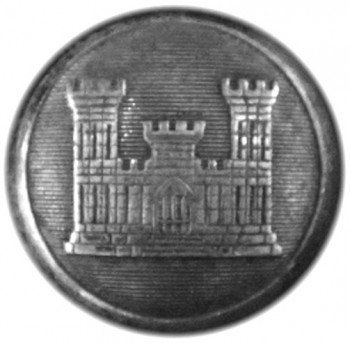
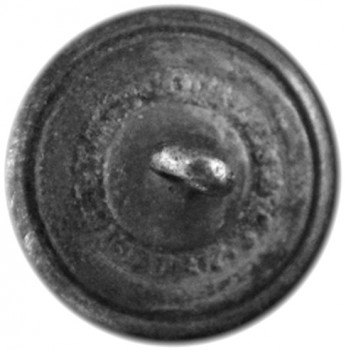
1849-61 New York 7th Militia Regiment, 10th Company Engineer Corps
Color: Gold!
Metal: 2-Piece, Low Convex Silver Plated Copper.
Size: 20mm.
Albert’s Number: NY 40: RV 10
Tice’s Number: NY224A.1
Variation: Fortress on an Evenly Lined Field.
Present Condition: An Excavated Example, Strong Planchet Condition, A Strong High Relief Pattern Remains.
Isabela’s Notes: This button’s pattern depicts a Bastion with Three Towers on an evenly lined field. There is a small raised edge border. Originally organized April 1847, and then designated the 10th company in 1861.
Reverse Button Analysis: This is a two-piece button with a loop shank. The shank is is original, straight, and intact. .SCOVILLS &Co./ WATERBURY rmdcwith a stippled channel.
